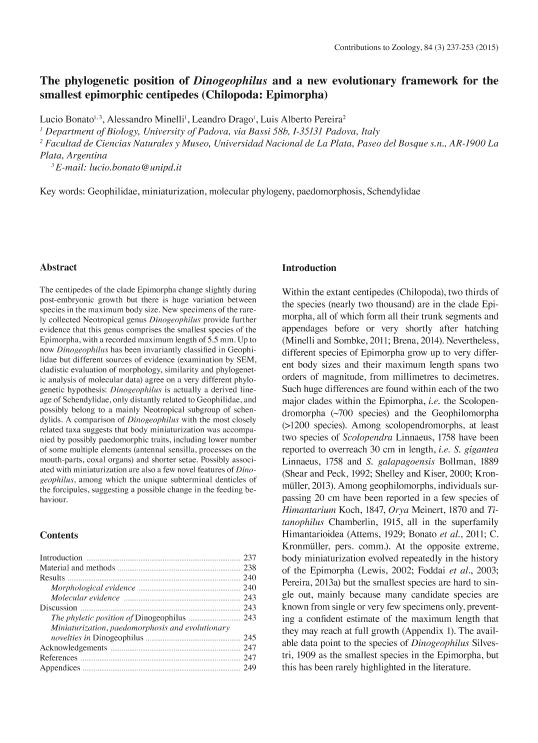Artículo
The phylogenetic position of Dinogeophilus and a new evolutionary framework for the smallest epimorphic centipedes (Chilopoda: Epimorpha)
Fecha de publicación:
09/2015
Editorial:
SPB Academic Publ
Revista:
CONTRIBUTIONS TO ZOOLOGY - (Print)
ISSN:
0067-8546
Idioma:
Inglés
Tipo de recurso:
Artículo publicado
Clasificación temática:
Resumen
The centipedes of the clade Epimorpha change slightly during post-embryonic growth but there is huge variation between species in the maximum body size. New specimens of the rarely collected Neotropical genus Dinogeophilus provide further evidence that this genus comprises the smallest species of the Epimorpha, with a recorded maximum length of 5.5 mm. Up to now Dinogeophilus has been invariantly classified in Geophilidae but different sources of evidence (examination by SEM, cladistic evaluation of morphology, similarity and phylogenetic analysis of molecular data) agree on a very different phylogenetic hypothesis: Dinogeophilus is actually a derived lineage of Schendylidae, only distantly related to Geophilidae, and possibly belong to a mainly Neotropical subgroup of schendylids. A comparison of Dinogeophilus with the most closely related taxa suggests that body miniaturization was accompanied by possibly paedomorphic traits, including lower number of some multiple elements (antennal sensilla, processes on the mouth-parts, coxal organs) and shorter setae. Possibly associated with miniaturization are also a few novel features of Dinogeophilus, among which the unique subterminal denticles of the forcipules, suggesting a possible change in the feeding behaviour.
Palabras clave:
Geophilidae
,
Miniaturization
,
Molecular Phylogeny
,
Paedomorphosis
,
Schendylidae
Archivos asociados
Licencia
Identificadores
Colecciones
Articulos(CCT - LA PLATA)
Articulos de CTRO.CIENTIFICO TECNOL.CONICET - LA PLATA
Articulos de CTRO.CIENTIFICO TECNOL.CONICET - LA PLATA
Citación
Bonato, Lucio; Minelli, Alessandro; Drago Leandro; Pereira, Luis Alberto; The phylogenetic position of Dinogeophilus and a new evolutionary framework for the smallest epimorphic centipedes (Chilopoda: Epimorpha); SPB Academic Publ; CONTRIBUTIONS TO ZOOLOGY - (Print); 84; 3; 9-2015; 237-253
Compartir




